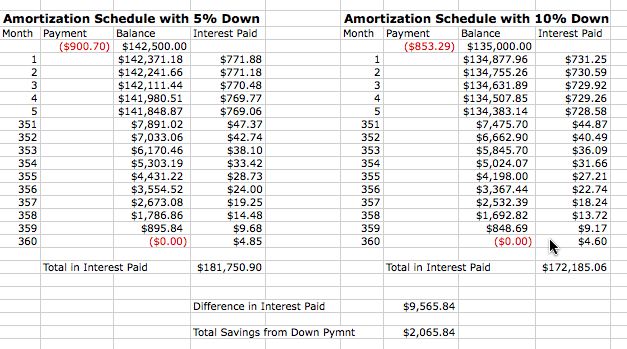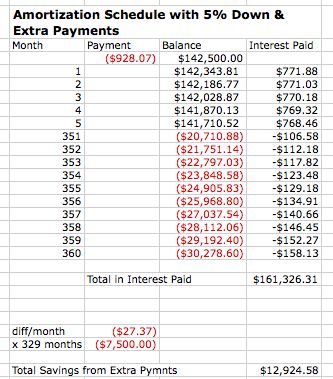I love spreadsheets.
I’ll be the first to admit that I’m a total spreadsheet nerd. My wife and I have been talking lately about buying a house sometime next year and that’s led me to do some number crunching in Excel, trying to figure out how much money we should put down on a house.
After some extensive crunching and comparing I’ve come across some interesting results, which to be perfectly honest with you I didn’t necessarily believe at first. Before I tell you what I learned though, I’d like to get your opinion on the matter.
[poll id=”6″]
Make sure you vote before continuing the rest of this post.
What did you say? My first thought was that the larger the down payment the more money you’re going to save in the long run. So was I right?
Nope.
What I found is that a larger down payment is essentially a waste of cash. There’s not much point to paying more down on a home, even if you have the available cash. In fact if you really want to save money I discovered that you’re better off taking your cash and applying extra to your monthly payments. Doing this will actually save you more money than if you had just put all of your cash down on the house.
Another obvious advantage to keeping more cash on hand is that your cash can earn interest while it’s hanging out month after month slowly whittling away as you take a small amount every month and apply it as an extra principal payment on your mortgage.
Check out what I calculated in Excel, based on a $150,000 purchase price and a 6.5% APY on a 30 year mortgage.
The main number to check out is the total savings from a higher down payment. The magic number is $2,065.84. Now that’s not per year, or even per decade. That’s a total savings of $2,065.84 over 30 years. That’s not much, and is arguably not worth paying an extra $7,500 down when purchasing a home.
Now check this out:
Here’s where it gets interesting.
Assuming you had $15,000 that you could put down on a home, but decided to only put down $7,500 and apply the rest of the $7,500 over the entire length of the mortgage you would save almost $13,000 dollars, not to mention that you could easily earn a return of 2-4% if you were to stash that $7,500 in a money market or other liquid savings accounts.
By doing this you’d also cut down the length of the loan from 360 months to about 329 months – a difference of 2.58 years.
Interesting isn’t it? The idea then is to pay down as little as possible, while saving up as much as possible. That way you can run some numbers and amortize your extra cash over the life of the loan. You’ll save yourself thousands of dollars, pay your loan off early and even let your extra cash work for you in a savings or money market account.
Win, Win, Win.
Update (Dec 11): I made a few clarifications about large down payments on a home and also want to leave a few disclaimers about certain things that I did not take into account. First you’ll notice that the monthly payments are not equal on the first picture I showed you. If you were to pay equally with the 10% and the 5% down then you would save a lot more money with the 10% down payment. Second there are no other variables included in the formulas I used, such as a possible lower interest rate or extra costs such as PMI (private mortgage insurance). Personal finance is completely personal and you should definitely do some research on your own with actual mortgage lenders if you are considering purchasing a home. Good luck out there!


7 responses to “Does A Large Down Payment Save Money In The Long Run?”
I haven’t personally looked into the prospect of buying a house, so I’m not as up on mortgages as I should be. I could talk home equity until the cows come home, but mortgage is a different animal entirely. That said, I don’t really see how your numbers reflect more savings in 5% as opposed to 10%. The more money you put down, the less interest you’re paying on principal. Roughly translated, that means more savings for you.
So, help me out here. How are you figuring that you’re saving more by putting down less?
Kristy @ Master Your Cards last blog post..20 Ways I Plan to Keep My New Year’s Resolutions
Very interesting Joe. I’m assuming the time value of money also plays a role here? With a fixed payment over the life of the loan, the real value of that payment amount will gradually erode as inflation works its magic.
Blakes last blog post..The Power of Measurement
To be honest with you Blake I didn’t actually figure in the time value of money. I’m actually curious as to how the numbers would work out if I were to do so. Interesting.
Hi, possibly this entry may be off topic but anyways, I have gone surfing about your website and it appears really cool. It’s obvious that you know the topic and you seem fervent about it. I
Great comment about private money
Your spreadsheet has a flaw: you subtracted your extra down payment difference of $7,500 from the “Difference in Interest Paid” which you assumed made your interest savings only $2,065.84. This is a mistake.
What you need to do is look at total down + total principal + total interest payments over the life of the loan.
In both cases of 5% and 10% down: total down + total mortgage principal = purchase price = $150,000.
However with 5% down you pay $181,750.90 in total interest.
Whereas with 10% down you only pay $172,185.06.
That is to say, the only true variable is the loan expense, AKA interest, so you should leave the “Difference in Interest Paid” column alone – this is your total savings $9,565.84.
Scott,
You’re absolutely right, I didn’t exactly compute that correctly. Thanks for pointing that out. Now, the idea behind this post I still think is worth considering — in that it might not always make sense to pay the maximum amount down you can afford if you have the option to pay less than the maximum. It’s all personal and a decision each person will have to strongly consider before making a final decision.
Thanks for the comment!